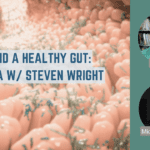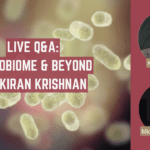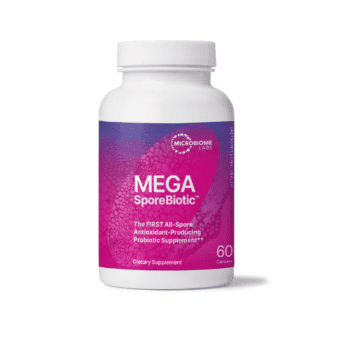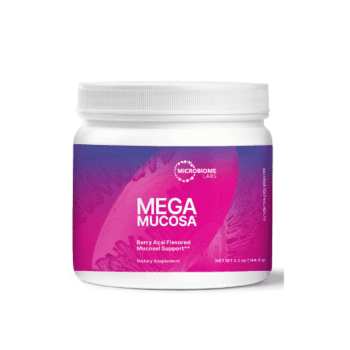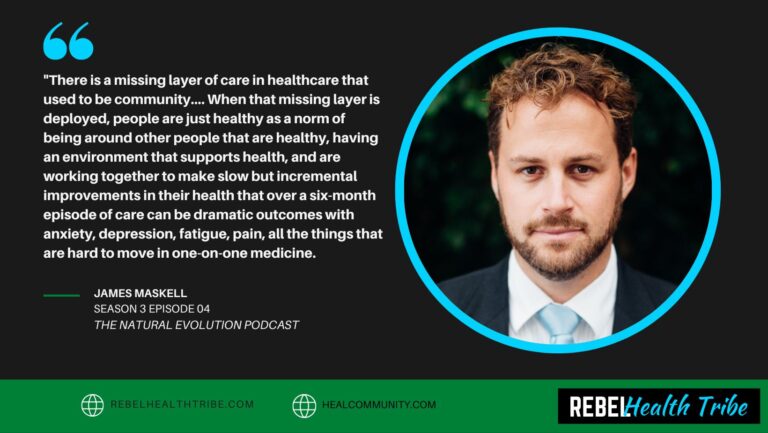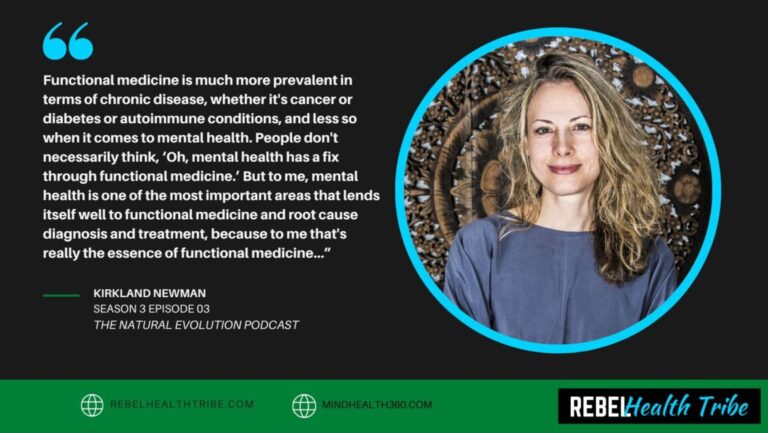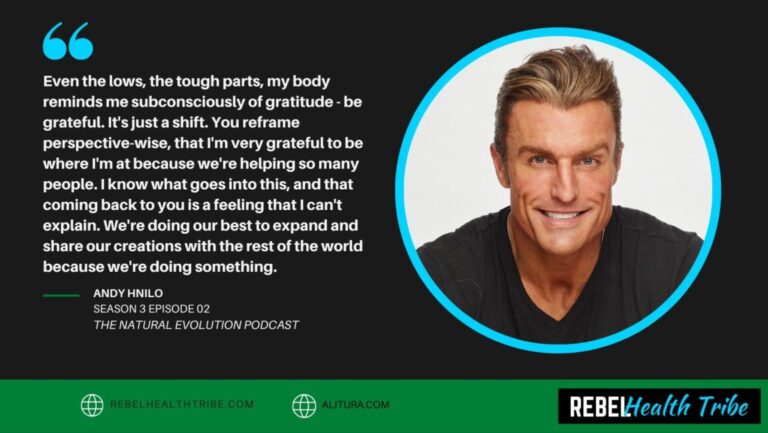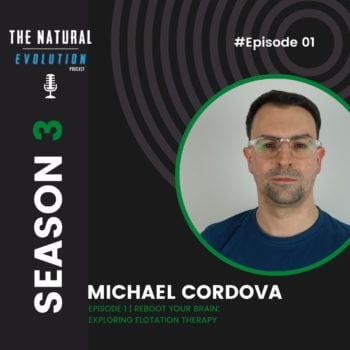
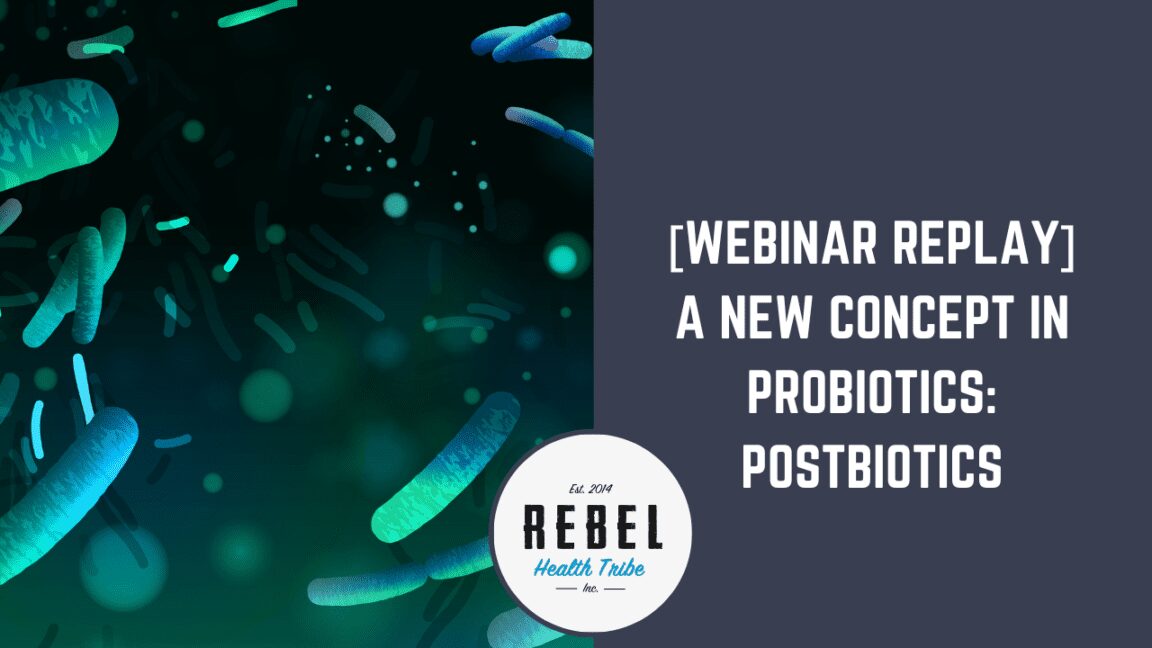
More Posts from
AutoImmune & Chronic Disease
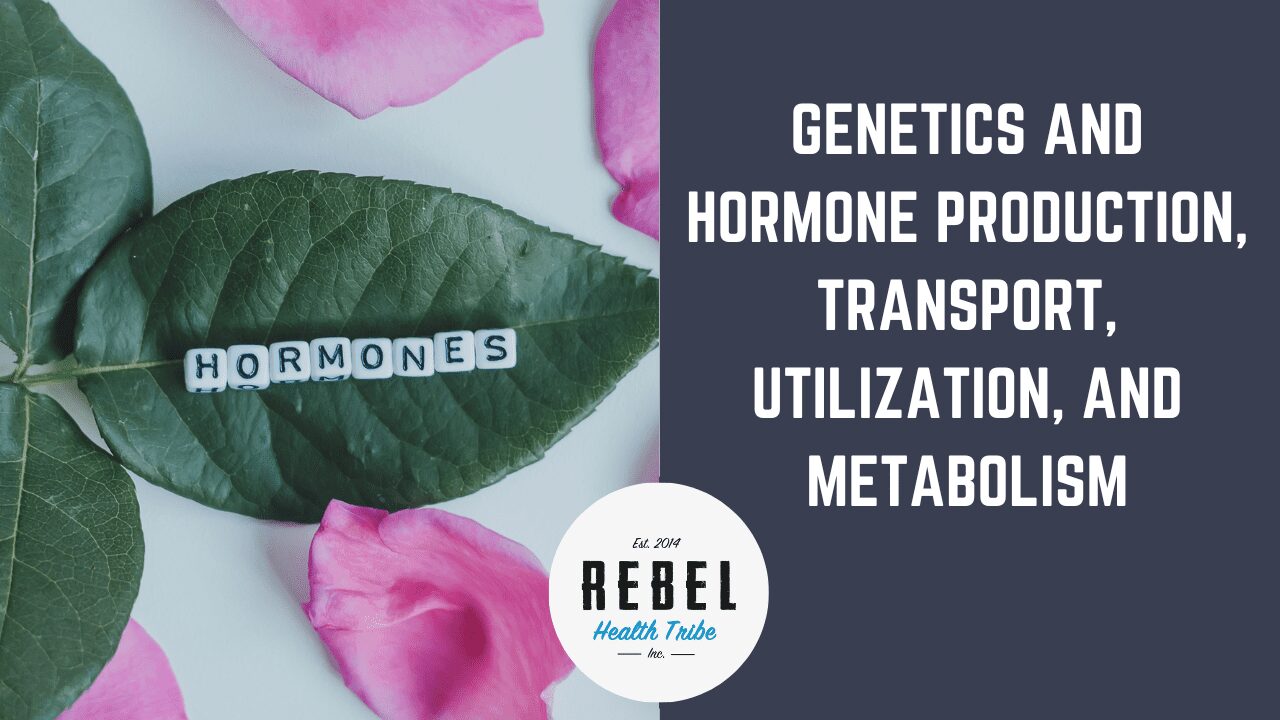
Genetics and Hormone Production, Transport, Utilization, and Metabolism
Our genetics play a larger role in our hormones than
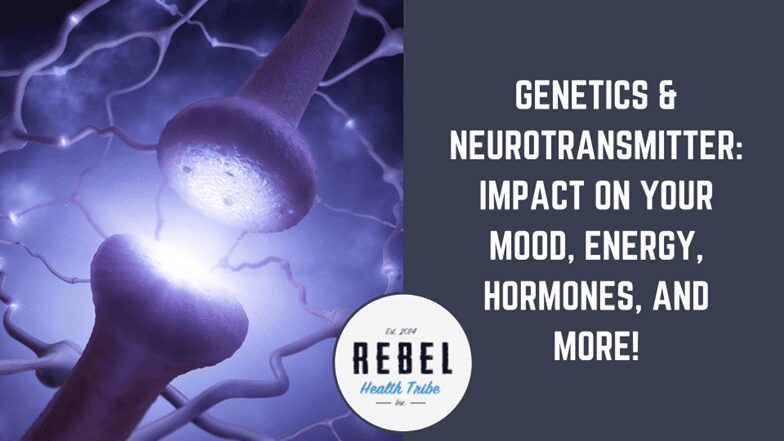
Genetics & Neurotransmitters: Impact on Your Mood, Energy, Hormones, and More!
Have you wondered why an antidepressant didn’t work for you?
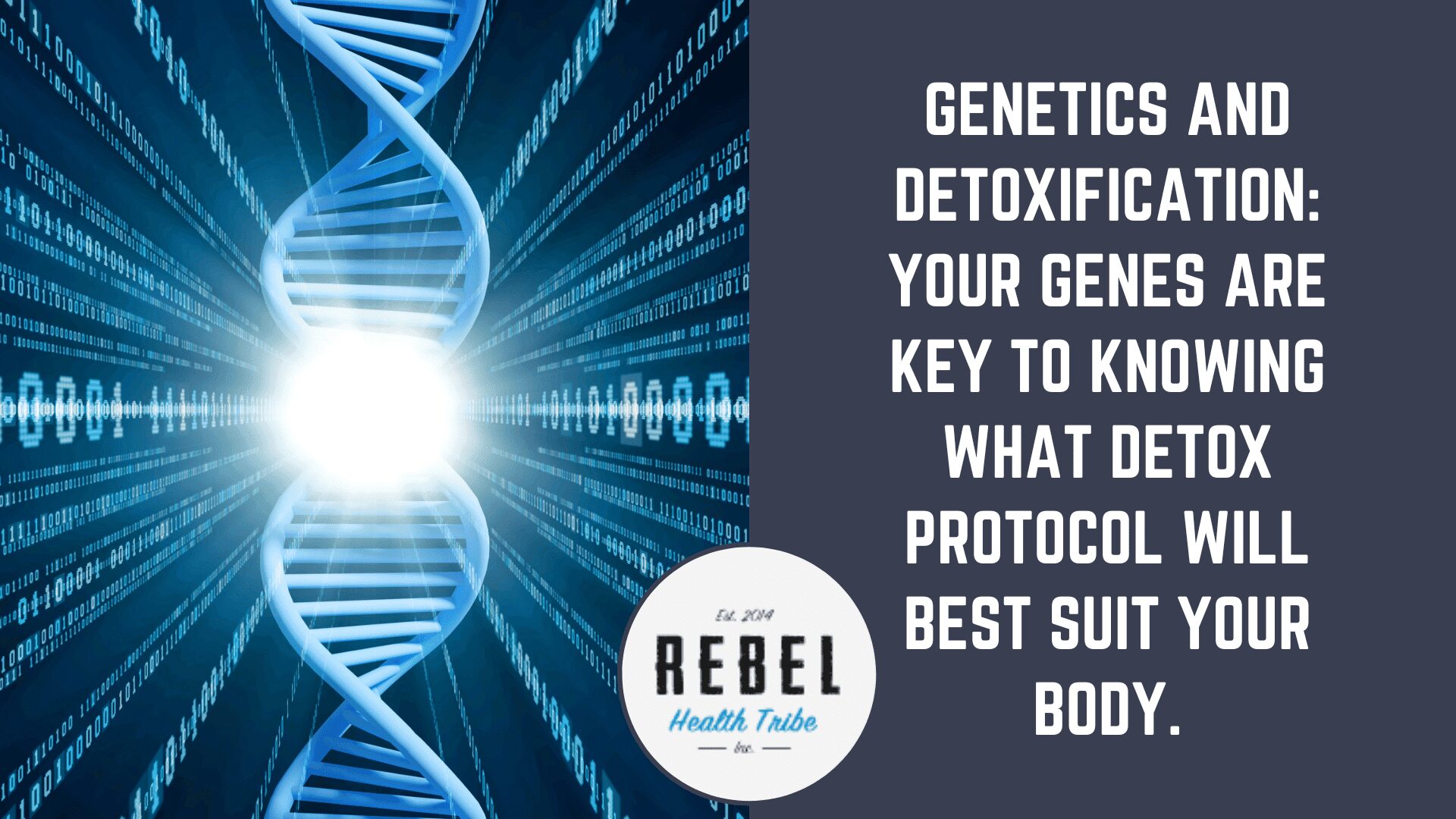
Genetics and Detoxification: Your genes are key to knowing what detox protocol will best suit your body.
https://vimeo.com/821487331 If you’ve ever bought a detox kit off
A New Concept in Probiotics: Postbiotics
with Steve Wright, Digestive Specialist & Founder of Healthy Gut
One of our favorite guest experts, and formulator of one of the best natural supplement lines on the market (Healthy Gut), Steve Wright was able to join us for a LIVE webinar.
We discuss a new topic we’ve never gotten into much here at RHT – Postbiotics (or paraprobiotics). We know you’re into gut health and microbiome info, so we’re sure you’ll find this discussion interesting! This will finish with an introduction to HoloImmune – a new postbiotic from Healthy Gut that we’re adding to our shop!
This is the first non-Microbiome Labs probiotic product we’ve ever decided to carry in our RHT retail shop, so you know it’s a big deal!
Here’s a sneak peak of what we cover and what is possible with postbiotics :
- Supports upper respiratory immune health year round
- Aids in Skin-Immune reactions and oral gum health
- May Balance under-active or overactive immune systems
- May Increase SIgA, a strong protector of gut-immunity
- Supports stress and age related decline in immune function
- Activates special pDC cells, the leaders of the immune system
Webinar Transcript
Michael Roesslein:
All right. We are live and it looks like people are trickling in. I know this one is pretty early in the day, in the morning. So thanks to everyone who is hopping on this morning. We’ll let people hop in for a minute. Steve, how’s it going?
Steven Wright:
It’s going well. We’re halfway through our house remodel here, so I do apologize if there’s some random noises or whatever happens.
Michael Roesslein:
No worries.
Steven Wright:
How are you?
Michael Roesslein:
I’m good. I’m good. No house remodel here. There’s some construction next door, so we’ll see. There’s constant jackhammers pretty much in the summertime here, because there’s a lot of renovations that go on in these old buildings. People buy old places and then fix them up, and so the summertime is when all of that work happens. But yeah, I’m good. It’s the end of a long day for me, the beginning of yours, probably.
So today we’re going to talk about some interesting stuff that I don’t think we’ve ever… I think Juran has mentioned the concept of postbiotics or paraprobiotics, or whatever term we’re going to use for them, in webinars and trainings that we’ve done, but we’ve never carried a product that uses that kind of, I don’t know, approach, or organisms or technology or whatever we want to call it.
And I don’t know a ton about it, so I’m going to ask some admittedly naive questions, and we’re going to learn about what these organisms are, or how they function or what happens when we ingest them. And I want to know how this came about.
So before we jump into that, I want to reintroduce Steve. I always just assume everybody knows Steve, but Steve is the founder of Healthy Gut. They make awesome digestion focused supplements. We carry the Holozyme and the Tributyrine-X and the HCL Guard. And Steve makes new products, and then I find out about the new products. And Steve’s products are always awesome, so then we bring him on to talk about them. And we add them to our shop because it’s a line that we feel really confident in. The results have been really positive with the other products, and for our customers and for ourselves.
I actually… We mistimed our traveling with supplements and stocking up of supplements, and just ran out of Holozyme and we’re using some nonsensical digestive enzyme. And the last couple days, Mirs had issues with foods that she did not have issues with before, and we noticed it right away.
Steven Wright:
Oh wow.
Michael Roesslein:
So her sister’s coming in a few weeks and she’s going to bring us a new inventory stockpile of things. But shipping stuff here is almost impossible and very expensive. So we learned the hard way, but that’s why we want to do these webinars, is to give you guys a ton of education on these products, and help you decide what’s best for you and who might want to use them.
And this one is really interesting. So thanks for being here, one. And two, I guess just give us the introduction to what… It’s called HoloImmune and it’s considered a postbiotic or a para-probiotic. I’ve seen both words used. What is it and what does that mean?
Steven Wright:
Yeah. So we’re going to go with paraprobiotic now because postbiotic is seemingly co-opted by the marketplace now to mean almost anything.
So para literally means dead or killed. And so this is a heat-killed probiotic, three strains of heat-killed probiotics coupled with beta glucans. And so we can break this down over the next hour or however long we go here, but paraprobiotics, to define that term, are heat-killed. But why would they do that? Because there’s a lot of talk about how you want your probiotics to be alive or to survive, or things like that.
Well, when researchers are looking at how do they get effects in animals or in humans, they do all kinds of crazy things. And so when researchers realized that probiotics don’t attach and repopulate our guts, 20 years ago they started realizing that, they started to test everything.
And one of the things they tested was, what happens if you kill a probiotic strain as it’s growing from an immature cell to a adult cell. And what they found is that the membrane, what makes up that membrane and the receptors on that membrane, change in the life cycle of the cell. And so they would heat kill it when it was immature, or before it was an adult cell, and then they would give it to animals, and then they would give the live, adult cell, and they realized there was different benefits. Or sometimes no benefits from the adult cell that was alive, but benefits from the dead, immature cell.
And so the paraprobiotics inside of HoloImmune are immature, heat-killed, shelf stable cells that are designed specifically for immune benefits. These were self-selected by human and animal studies for gut immune benefit.
Michael Roesslein:
Okay. And this is not new. It’s new to us. We haven’t talked about it on our stuff before, and we’ve never had a product that fits in this category, but this is not a new thing. Right? This has been pretty well known for a long time, that there are these organisms that, if ingested, even when they’re dead, they trigger these immune responses that can then manipulate overall immune function and responses in the body. Right? This is a pretty well established thing?
Steven Wright:
Yeah. It’s been used in Japan for 10 to 15 years and they’ve known about it for about 20.
Michael Roesslein:
Okay. So this isn’t one of your “deep digging at 4:00 AM on YouTube” finds that pop into some of your reports?
Steven Wright:
Well, I mean, that’s actually how it came about. You asked like, “How did it even come about?”
Michael Roesslein:
Yeah, yeah.
Steven Wright:
It came about because I wanted to build the best immune system I could have when the pandemic kicked off. And I wanted to build it for my family who have autoimmune conditions and cancer and all kinds of things. And so I was concerned. We didn’t know anything in those toilet paper shortage days. And so I was concerned. And so I was like, “All right, what’s the best prebiotic? What’s the best probiotic in the world? What should we all be taking?”
And when I looked at influenza and cold studies for probiotics, I was disappointed. I was like, “This isn’t… ” I mean, they’re okay. It’s just not super powerful data that I want to hang my hat on for my health and for my family’s health.
And I kept running across these paraprobiotics at that point. I was like, “What the heck are these things?” Like, “This doesn’t make any sense. I never heard of these things. No one’s ever talked about them.” And so that launched the rabbit hole of, okay, so there’s this whole part of the gut immune connection where you can take dead probiotics in the gut and it sort of modifies your immune system, and makes it smarter, basically. And that’s when the light bulb went off for me around, “Wow, is there a way in which… “
So no one’s responding to us, huh?
Michael Roesslein:
No, the first one, I had it on the wrong setting. So I’m just doing a quick hear-and-see-us check. Usually I would get blown up if they can’t see us and hear us, but I forgot to do a check-in when we started. So sorry about that.
Steven Wright:
Yeah, no, that’s all right.
Michael Roesslein:
Drop in the chat if you can see us and hear us, please, and let us know, and then we will continue on the origin story of HoloImmune. Okay.
Steven Wright:
Okay, cool.
Michael Roesslein:
We’re good. Go ahead.
Steven Wright:
So, I wanted the best, I wanted the strongest immune system. So I pulled up all the stuff I had, like D and A and zinc and all this stuff. And I was like, “Oh, strong immune system. Right? Super strong.” Very American, very Western. And as I got into the research about the immune system, which I’m not an immunologist, I’m not an expert on the immune system, but I did read a lot.
And what I started to realize was that you don’t want the strongest immune system. You want the most effective or efficient, because if your immune system responds too aggressively, it actually kills you. And it thinks it’s doing the right thing, but it actually ends up killing you through a cytokine storm or something else. And so it quickly became clear to me that you want the smartest immune system possible. You don’t want the strongest.
If it needs to be strong, it pulls out of Jack hammer and jack hammers. If it needs to use a feather, it uses a feather. And so then I started to look at like, “Okay, how do you make a thing stronger?” And it’s like, “Well, you don’t want to just amplify sort of cracks.” Right?
So if our immune system’s out of whack, if it’s supposed to be on a teeter totter and it’s not balanced, but one side’s out of whack, and then we make it stronger, we just make that thing get more out of whack.
And so that’s when I came back to adaptive. Okay, we want to make something adaptive for the immune system and then what’s out there. And so that’s how we slowly, over many months and actually over a year, ended up on these three strains and beta glucans.
Michael Roesslein:
Before we get into the strains and how you chose them, what are beta glucans?
Steven Wright:
So beta glucans are basically a part of the cell of usually mushrooms or yeast. And so it’s part of the cell wall. And that cell wall has been used for several decades, now, for immune benefit in animals and in humans.
The reason why it was included in this product, and the reason why I love it for gut stuff, is that it boosts secretory IgA, which secretory IgA is one of the first line defenders. I think of it as part of the innate immune system for the gut. And it helps block incoming toxins. It blocks incoming bacteria. It’s sort of like the bulldog or guard dog of the small intestine.
And you can measure it on tests, so if you see it super highly elevated on a test marker, you can typically find a parasite or some sort of infection. And if you see it super low, you typically find a history of an infection that either didn’t get cleared or just was recently cleared. And so it’s a pretty cool marker that we can actually measure. And we know from a lot of research, both supplement studies in humans and in animals, that it is very effective in helping our immune system.
Michael Roesslein:
We get a lot of questions about secretory IgA, actually, and how to raise it. A lot of people, on their lab tests, see it low, that are in our groups and in our circles. And I’ve seen a lot of fuzzy “this may raise it” claims from some things, but that’s interesting, the beta glucans.
Steven Wright:
Yeah. Minimum 100 mg, and then studies go up to 500 mg, and it seems potentially like there’s a dose response there, meaning the more you take, the more you get. But with the immune system, again, you never want to push it too hard in any one direction because we want smart and balanced, we don’t want strong and misfiring.
Michael Roesslein:
Yeah. Yeah. And you mentioned that you have autoimmune in your circles, and I know that with autoimmune folks, there’s probably some on this webinar, that taking things that “boost” or “strengthen” your immune system isn’t always what is safe over there for those people. So driving things too high, not good.
So you mentioned three. There’s three strains, specifically.
Steven Wright:
Yep.
Michael Roesslein:
There’s probably a lot more than three strains that exist, that are used in paraprobiotics. So knowing you, you probably read every study ever on every single strain that’s ever been used for paraprobiotics, but if that’s not accurate, how did you choose the… What are the three and why did you choose them?
Steven Wright:
I mean, it did start with a very crazy, scientific review of as many paraprobiotic strains that I could find, and then a narrowing down of which ones were in research phases, versus which ones are commercially viable. And then from there, it was pared down to which ones actually had data in animals and in humans. And then what was the quality of the data in the humans, and what was the mechanism of action?
Because again, I was trying to build the best gut immune product to make a smarter, not necessarily stronger, but an adaptogenic, smarter product. And so I was looking for specific things. Like you said, I wanted something that would help people with autoimmune conditions, which are typically Th2 dominant folks. So we need something that sort of helps either reduce that dominance or block it, or raise it up in some capacity, modulate it.
But also I wanted… My mom has really aggressive seasonal allergies, and I used to have pretty aggressive seasonal allergies back when I was a lot sicker. And so I wanted something that may help her as well. And so I was looking for things that modulated the Th1 side of the immune system, too.
So that’s how they got selected. So the first one is Lactococcus lactis strain, and it’s called Immuse, or LC-Plasma. So if you search Immuse, I-M-M-U-S-E, or LC-Plasma, you can usually find the studies. They have 14 trials in humans, and then I think another 14 or 16 in animals. So they’re probably the most well researched of the three in humans. And they’re one of the coolest, in that they’ve looked at everything from athletic performance to clearance of influenza in humans, to just generalized, all year round support of the immune system.
So this strain specifically, one of the things that… The reason why it’s included is that it boosts these things called plasmacytoid dendritic cells or PDCs. And during my research, I found out that… If you don’t know, there’s two sides of the immune system. There’s an innate and the adaptive. Innate is what’s happening automatically from the cellular level, right away in response to anything. And adaptive is sort of antibodies and long term memory and more complexity.
And the innate has to talk to the adaptive, right? It has to… The communication flow, if it doesn’t send enough information, or if it sends the wrong information, or if it’s crying wolf all the time, the adaptive immune system’s going to get very confused, annoyed, overworked. And part of how the crosstalk happens there, in the communication pathways, is through our dendritic cells. And the PDCs are actually sort of considered the leaders or the commanders of those dendritic cells and of that communication between the two sides.
And so that was one of the breakdowns that I identified as making a smarter immune system. Right? If you can’t get your innate immune system to talk to your adaptive immune system and say, “Hey, I need some help,” or, “Hey, this thing’s bad,” then you’re always going to have an ineffective immune response.
And so something that specifically boosts PDCs in research in humans was a really cool find, and something that was really interesting. Plus it had those added studies around influenza and around athletic performance in humans, which was some of the gold standards I was looking for.
Michael Roesslein:
Sweet. That one’s Immuse, right?
Steven Wright:
Yep.
Michael Roesslein:
That’s the name of the raw material product of the strain? Yeah.
Steven Wright:
Yeah, yeah. It’s the trademark name of the strain.
Michael Roesslein:
Yeah. I’ve seen that type of thing in a lot of the products we work with. There’s one of those for CoQ10 that’s the best kind of CoQ10. There’s one, the Mag threonate we’re using is the Magtein. So yeah, it’s a trademarked raw material.
What are the other… And that all sounds pretty incredible. I’m going to slow it down. One, you mentioned Th1, Th2 quite a bit there. Do you want to elaborate? Is that the innate? Just because I know people might not know that term. So can you just explain those a little bit?
Steven Wright:
Yeah, sure. So that’s on the adaptive side. So on the adaptive side, think B cells and T cells, and then…
PART 1 OF 4 ENDS [00:17:04]
Steven Wright:
… so on the adaptive side, think B cells and T cells. And then on the innate side, think natural killer cells, white blood cells, those types of things.
And so on the adaptive side, you have T cells and B cells. T cells, there’s typically Th1 side and Th2 side. And in the research, we find a correlation between Th2 dominance in autoimmune conditions and Th1 dominance in allergy conditions, which is really weird, considering if you have an autoimmune condition, oftentimes, you have a lot of allergies too.
And so as I thought about this more, it, I think it’s more about the hyperfluctuation between the two. It’s more about the volatility of the balancing between the two. Because technically how it’s supposed to work is you have T helper cells, and T helper cells are sort of like the referee or the balancing agent between the two sides of Th cells. And so T helper is supposed to come in. If the Th2 gets too aggressive, it pushes it down. It inhibits Th2 and pushes up Th1 and vice versa. So that’s why a lot of people will be very excited when they learn like, hey, this product improves your T helper cells, or anything that involves T cell differentiation and making the body smarter with its T cells, they’ll be very excited about that because you can help sort of modulate or balance those two sides, which is what we want. That’s the smartest immune system we can have, is one that’s very regulated, and if it has to get out of whack, it quickly gets back into order.
And so that’s I think part of what we’re struggling with inside of innate immunities with some of these conditions, is that you’re locked into one pattern, and that’s one of the misfires that I think we’re all trying to solve for at some level.
Michael Roesslein:
Perfect. Thank you. So balanced and regulated much better for most people than strong and powerful. I like how you said you got all American on your immune system, but more is better. Stronger is better. Faster is better. But in a lot of the responses, especially with COVID, what a lot of people now are familiar with the term cytokine storm, and everyone became an immunologist overnight over the last couple years, but that term would’ve been known a couple years ago. And really that is just the body’s innate immune system responding wildly to the infection without the regulation, and then a lot of the damage caused by that and other similar infections is by the immune systems like collateral damage in the initial attack.
So balance would be a lot better than stronger, because most of what they’re recommending for that now is getting the immune system calmed down, the response calmed down, which you’d think with an infection, oh, I want as much attack as I can have, but it’s really the right kind of attack and the right balance. So the other two strains, you want to tell us a little bit about those?
Steven Wright:
Yeah, sure. And I just want to double click on what you just said there, which is that the ultimate goal for our bodies, and I think the lens you can view your own symptoms through, is basically how regulated are you to your environment? So if in your environment, you look around, and other people don’t have stuffy, watery eyes and they’re not suffering from seasonal allergies, but you are, that means your body’s not calibrated properly to your environment. Now, if everybody has it, like literally everybody, 90 plus percentile, then maybe this is a global issue for all bodies. Same thing goes for food sensitivities. And then the same thing goes for autoimmune conditions. If everybody’s developing Hashimoto’s, then it’s probably not your body. But if it is just some subset set of people, then it’s probably some part of your body and its inability to regulate with incoming information from the environment.
And so that’s really what we’re searching for, is just the right amount of pressure and just the right amount of backing off. Because as you said, there is collateral damage in every single war. And so we want just enough to get the job done and then we want to repair as soon as possible. It’s very much analogous to a really healthy relationship with an intimate partner or something like that.
Michael Roesslein:
Yeah, that makes a lot of sense, to look around and make sure if it’s you, then it’s something going on in your immune system, where I’ve always been the lucky one that doesn’t have the seasonal allergies and I’m walking in the room and somebody’s dying and I’m okay. And so it’s … I was just taking some notes on your sharing there.
So we’ve got … you mentioned food sensitivities. I actually want to stop there for a second because our audience has a lot of food sensitivity issues and that’s kind of how they ended up in our world to begin with a lot of them. And so food sensitivities can be an overreaction of the immune system. And so have there been … I don’t know if any of the studies on any of the strains or any para probiotics showing a reduction in food sensitivities, or do you think that would be kind of like an indirect potential result from regulating the immune system?
Steven Wright:
So none of the strains have studied that specifically, but they have studied IgE antibodies, so the lactobacillus acidophilus strain L92, specifically looked at inhibition of Th2 antibodies, which are generally linked to food sensitivities being higher. That’s typically what they’re measuring on a food sensitivity test. And our customers, some subset of them, I don’t know yet, I don’t know if it’s 20, 30, 40% of people taking the product so far, have reported in their reviews as well as into customer service, that they are seeing an improvement pretty rapidly in the reactions, the food reactions that they’re having, whether it’s histamine and they consider themselves histamine-dominant, or if they’re just a general leaky gut food sensitivity person and they seem to be able to handle more foods or the foods that they used to have somewhat of a struggle with appear to be less struggle. And so I believe that’s part of we’re basically improving the environment that the food, the chaotic environment that food is digested in. We’re sort of dampening and regulating that environment so that those signals don’t just get fired off more intensely or more rapidly.
Michael Roesslein:
Yeah. Because if the body’s not in … if the gut and the body’s not in a … and there is no local. So if the gut puts … if you have leaky gut and there’s just like an inflammatory state in the gut, then you’re in a chronically inflamed state in your body. There’s no … it doesn’t work that way. So if you’re in a chronically inflamed state where some of this is really, really heightened, the body’s more reactive to the food. Is that what you’re saying?
Steven Wright:
Yeah.
Michael Roesslein:
So then by having something kind of quell that and regulate that a little bit, then the food coming in the body doesn’t … isn’t already having a, I don’t know, smash everything party when the food walks in the door.
Steven Wright:
Yeah. Like again, let’s use analogies because the immune system and the gut are very hard to put your finger on. So let’s say you’re having …
Michael Roesslein:
I’m failing at that, but trying to use metaphors and analogies because I know how complex the immunology gets.
Steven Wright:
Yeah. You’re not failing at it. I mean, let’s just go one step farther. Like let’s say food … let’s say you’re having hay fever or whatever and you look outside and you’re like, “Ah, there’s that ragweed or whatever. There’s that bush that I’m allergic to, that oleander or whatever.” There’s a few things you could do. One is you could close your windows and get a better filter that would help remove those potential toxins from coming into your body. This would be like going on elimination diet or cutting out the food that you’re most sensitive to. But then when you walk outside to go get in your car, unfortunately you’re exposed to it again. So then you could go as far to like just rip out all the stuff outside your home, just cut it all down. I’m getting some feedback on your end. I don’t … or my end. I’m not sure who’s …
Michael Roesslein:
Hold on. I can mute myself and see if that helps.
Steven Wright:
So now you’re not getting it from your yard and you’ve got these filters in your house, and then if you go take your dog for a walk, you realize that the rest of the neighborhood has it. And so in a way you’re never going to get away from it, and so that’s kind of a similar analogy to the food sensitivities. We don’t necessarily want to just focus completely on removal of foods and removal of toxins because it’s only one part of the equation. And instead we could focus more on the environment and how you handle that interaction with the food.
And so that’s what I think helping make the right amount of IgE antibodies would be doing. If we make more T helper cells, then we make just the right amount of IgE antibodies. Because we don’t want no … we don’t want zero production. We don’t want a thousand. We want the right amount for that experience that day. And so that’s what we’re looking to do with any product that’s going to be adaptive or make a smarter immune system.
Michael Roesslein:
Having more regulators, which is the T … for those who got lost a little bit, the T cells, the T helper cells are the ones that regulate the immune response. So having increase of those is more regulatory, but I like that analogy better than my smash things party one. So nice work on that.
So you mentioned another one of the strains, the one that does have a modulatory effect on the IgE antibodies and studies. Which one was that, and what else does that one shown to do?
Steven Wright:
Yeah, so that’s Lactobacillus acidophilus L92, and this one’s actually been used for the longest. This one’s been around in Japan for, like I said, I think 20 years, but definitely commercially viable for, for over 10. And so it’s an acidophilus strain, but again, it’s killed prematurely. And this specific 92 strain was chosen for its inhibition of IgE antibodies I think in mice. They were looking at like a hundred or a thousand strains just trying to figure out which ones work best on the immune system.
So they’ve also done studies around … specifically in humans for pay fever or atopic dermatitis as well as eczema in humans. And they’ve seen a reduction in the symptomology, so it doesn’t treat these issues. This product, WholeMune doesn’t treat any condition. It just supports the immune system to have a better response, but they did show a lessening in the symptomology regarding wheezing and running eyes and stuffy nose and all those types of things in the L92. So the majority of its benefit comes through the inhibition of the IgE antibodies and the support of more T helper cells.
Michael Roesslein:
Cool. And the third one?
Steven Wright:
So the third one is called lactobacillus plantarum L137. It’s trademarked as Immuno-Lp20. So you can search either one of those. This one has like six studies in humans so far I think, and then another 10 or so in mice and rodents. This one is pretty cool because this is more on the Th1 side. So this is going to be helpful for type one interferon, which is important for viral inhibition of incoming viruses, but also it’s important for … it helps sort of boost the Th1 side, which again, people will be like, “Oh my gosh, I don’t want to take it because I might be Th1 dominant.” So far, we’ve given this product out to a lot of really sensitive folks who do have those concerns and we have not seen it exacerbate things that are out of regulation. It helps it bring it into regulation.
But it does … the studies suggest that it helps reduce periodontal pocket disease, the pocket depth of like the really strong pockets. It may reduce inflammation from metabolic syndrome and then it has that viral type one interferon in humans. And so again, this goes back to the question of like, wait, what’s going on? We’re taking a dead probiotic and it might help reduce pocket depth for periodontal disease in humans. Like what? So it’s a really cool thing.
Michael Roesslein:
And you’re taking it orally, you’re not swishing this around the mouth.
Steven Wright:
Right. It’s in a capsule.
Michael Roesslein:
Yeah. That’s interesting.
Steven Wright:
It’s effective through the small intenstine.
Michael Roesslein:
It’s affecting the immune response that’s actually responsible for the pockets.
Steven Wright:
Correct.
Michael Roesslein:
You’re talking pockets of like where your gums recede really far, right?
Steven Wright:
Correct. Yep.
Michael Roesslein:
Yeah. That’s, that’s really interesting. And yeah, just to reiterate and hit that home, these are dead organisms. So they’re intentionally killed, they’re taken dead, whereas a lot of probiotics on the market will argue, it survives the stomach, it doesn’t survive the stomach. It gets to here, it delivers this many billions. There’s this many billions live organisms in it. Nope. Every single one of them is dead. And I don’t know if we fully understand all the mechanisms by which these things work, but the dead organisms, when they hit the immune system trigger these types of effects that we’re talking about here, which can be seen and measured in studies, and know that when this is ingested, this is the result. When this is ingested, this is the result. I don’t know how much is known or understood about the how or the why or the what’s actually going on there.
Steven Wright:
Well, I mean, we know some, we don’t know a lot. And this is true for all probiotics. I mean, you could make the argument that legitimately, well over 80 to 90% of probiotic research was done on organisms that were not in a special capsule, so therefore they probably died in the stomach, and then the research is like, “Well, they got to be alive,” but they didn’t use a special capsule when they did the research study. So I think …
Michael Roesslein:
I think a lot of probiotics are probably paraprobiotics.
Steven Wright:
I mean maybe. I mean, who knows? Like, okay, let’s say you take a hundred percent of a live probiotic. It’s one of those refrigerated kind, right? Like you have to … special refrigerated. What survives the stomach? Is it 70%? Is it 12%? Is it 1%? Is it zero? And no one’s done that. No, one’s done that on humans. And then everybody has a different stomach acid. Some people are low, some people are … most people aren’t high, but most people are lower than normal. What does that change things? We don’t have that data. But I mean, the truth is that acid at less than two is very good at killing things.
Michael Roesslein:
Yeah. Very good at killing things. I was actually writing some content earlier today about stomach acid and trying to insert some … when you’re trying to wow people with a factoid or a thing, and it’s like the stuff that our stomach acid can destroy or kill if it were outside of the body was pretty impressive. We have like a destruction machine in the middle of our torso. But these are already dead and they’re supposed to be dead. All dead.
Steven Wright:
And again, remember these are killed prematurely from being an adult cell. And what I think we’re learning about probiotics and about our immune system is our immune system, and especially in our gut, is always sampling the environment. It’s like literally … I can’t think of a great analogy, but there’s probably a good computer analogy around like always sampling the data, but it’s always sampling what’s coming in.
And so if we give it these bugs with a specific membrane, which is data, basically, it’s sampling data, they cause these extra mechanisms that we know in animals, and then we have some outcome data in humans. A lot of the data is not on more than like a hundred people, so the sample sizes yet aren’t drug level, which is why doesn’t treat anything. It just supports things. But it’s really interesting and cool that you’re taking something in your small intestine and you’re seeing neuro benefits. You’re seeing gum benefits. You’re seeing eczema …
Michael Roesslein:
Systemwide.
Steven Wright:
… and a lot of random rash data. I’m …
PART 2 OF 4 ENDS [00:34:04]
Steven Wright:
Of random rash data. Yeah.
Michael Roesslein:
I’m guessing for skin itchy things, skin condition, things, allergy type things, people who are sensitive to fill in the blank of pretty much anything. Chemical environmental sensitivities, overreactivity of immune system. There’s so many things that fall under that category, but not just that. Not just that to help quell that a little bit, but also you’re mentioning modulatory, regulatory. The first thing you mentioned was that the first strain was shown to raise secretory IGA. And so that is depleted-
Steven Wright:
Well, that’s beta-glucans. It’s not a strain of [crosstalk 00:34:42]
Michael Roesslein:
Beta-glucans. Yeah, the beta-glucans raised the secretory IGA. That is taking something from an underperforming, weakened, less reactive state and bringing it back up to a baseline. I’ve been buried with my nose in… We’re launching a whole new website next month that’s giant and huge and robust, and I’ve been buried under that. So I didn’t know right away that you had a new product and then somebody sent me a link to it from our audience and was like, “Hey, this stuff’s really cool. Are you going to have him on talk about this and carry this?” And I said, “Yeah, of course. That’s already in the works.” And then I sent you the email. How long have you guys been working with this with people?
Steven Wright:
Yes. It’s been underdeveloped for two years since March of 2020 when we started the project. It’s been on the market since March of this year.
Michael Roesslein:
Oh, okay. I’m not too out of the loop. I hit you up in May. So I was only two months out of the loop. You guys are awesome at gathering information and feedback from your customers, both the practitioners and the laypersons who are using the product. I actually want to chat with you about that, because I want to improve how we do that based on what I’ve seen that you guys do. So what have you been hearing? What’s the feedback? Who are the people that are taking this product? And what are you hearing from them?
Steven Wright:
Yeah, there’s several distinct classes. One is the food sensitivity folks or the histamine folks, I kind of lump them together. They are seeing an improvement in food classes that were generally out of bounds for them for many years. So for certain histamine folks, they get better, but they can’t tolerate strawberries or they can’t tolerate red wine or whatever. And so we’re seeing customer data that these people are making that next leap forward in food tolerance. Same is true for just generalized foods like broccoli or dairy or eggs or something like that. So there’s the food sensitivity crowd. There happens to be a weird neuro crowd, neuroinflammation crowd that I did not expect, and I did not see that coming from the research. These people seem to be somebody who tries the product thinking they’re trying it for a different benefit.
And then they notice a clarity, a cognitive quality. Some people describe it as what they want from coffee. Many of the folks actually don’t say they have brain fog. If I had asked them prior to buying the product, “Hey, do you have brain fog?” I don’t think they would’ve said they did. And they take one to two capsules. Most of them actually decide to take two capsules a day because it’s like a nootropic. It’s a clarity thing for them. So that suggests there’s some sort of brain neuro gut link that I’ve been researching and trying to dive into. I don’t have any conclusive answers at the moment.
Michael Roesslein:
I’ll guinea pig on that one. I’m pretty neuro inflame history of concussions and brain fog and all the different symptoms of that. Batiste Grosjean did a presentation for our brain and neuro master class on neuroinflammation and activated microglial cells and all of that type of stuff. And I was feverishly taking notes and started implementing some of the things. I’m on hour 47 of a fast right now.
Steven Wright:
Oh, nice.
Michael Roesslein:
And I do that every six weeks. I do three day fasts. I started implementing longer fasting periods and some other things that he had recommended. And I noticed an immediate shift in mental clarity. People don’t equate brain fog, but brain fog oftentimes is neuroinflammation. So I just wanted to throw out the personal experience there of things that I know that help neuroinflammation have helped me quite a bit with focus. And some of them I was taking because my hand hurt.
Steven Wright:
Interesting.
Michael Roesslein:
And I was like, “Oh, cool. Now I can think better.” So that’s interesting, and I like when people find accidental benefits in things and then become a group of people that find a lot of benefit that came out of left field. So what’s the third group?
Steven Wright:
So the third group is the skin people. So they have rosacea, eczema, rashes, unexplained stuff that no one’s ever been able to definitively tell them what this is. Now, it doesn’t treat those conditions. It just supports the skin health and basically the gut immune skin access. There’s a huge interplay there. And so people are using it for their random rashes and getting support from acne to rashes to just bumps and weird stuff there.
Michael Roesslein:
Very cool. Well, I’m going to put this to the test. We’ll get some brought over here when Mira’s sister visits next month. I have some minor strange skin bumps and some neuroinflammation. And she is a histamine person, food sensitivity. If she gets a mosquito bite, it turns into a golf ball. And if this could do away with that, you will be my wife’s hero, because mosquito bites turning into golf balls are the bane of her existence. And so we will see. We will see how that goes.
Steven Wright:
Yeah. Let me know, because we’ll both be learning at that point. I haven’t seen any mosquito bite research.
Michael Roesslein:
No, but that’s an overactive response. That’s a hyperreactive immune response. That’s a primed overreactive system getting introduced to a thing that should cause a reasonable stimulus that then turns into a giant golf ball. And that can happen with a bite on your skin, it can happen with a food when you eat it, it can happen with an infection when you get it and you’re exposed to it. Then your immune system starts destroying your own arteries. It can get all out of control. So food sensitivity, histamine reactive folks, neuroinflammation, neuro crowd, clarity, cognitive nootropic type effect and skin people, we call them. But rosacea, eczema, bumps, strange rash type of things, because all of these things are gut immune.
Steven Wright:
Right, right. The last group is your athletes/biohackers who can’t afford to miss a day. So several of the products, several of the strains have research on less lock… Geez. Less lost work days while taking the strain. So you basically give eight weeks of the strain to somebody across a whole company and then you track the placebo group, how many days did they call in sick? And then the active group, how many days did they call in sick? And the folks taking the paraprobiotics call in sick less. And so there’s exercised benefits, potentially time to exhaustion benefits from taking the product as well as basically losing less days due to called in sick from taking the product. That’s sort of the four buckets that use it.
Michael Roesslein:
Interesting. I’m fairly familiar with beta-glucans becabause the audience doesn’t know this when they’re watching this, but part of the new site launch is we’re two and a half exing the size of our shop and the products we’re carrying and the companies we’re working with, and I’m bringing in some really cool stuff. And one other product that we’re bringing in does have beta-glucans and I was researching them and I was like, “Why are these not a thing that’s more well-known? Why did I not know a bunch about beta-glucans until 2022 when I’ve been doing this work for 12 years?” And that, again, is not a new thing, not a thing that’s absence of studies, not a thing that’s a secret amongst people who know. So there’s benefits and effects of beta-glucans beyond what Steve shared here related to this product that are really cool and really interesting. Where do those come from? What is that?
Steven Wright:
Yeah. So ours come from yeast and that’s controversial and ours are 1,3/1,6. So they’re not purified down to only be 1,3. There is data from a very reputable company about just 1,3s in general. There’s other companies who use only yeast strains. There’s other companies that only use mushroom strains, and they compete with their marketing and they claim certain things. When I did a thorough review, because part of why I knew about beta-glucans is because Shay, my fiancé, soon-to-be wife, was diagnosed with breast cancer about three years ago. And in the literature, beta-glucans are linked with potential cancer benefits. And that’s part of why no one knows about it is because those companies, about 20 years ago, were aggressively pushing it and the FDA said, “Stop it.” And they said, “Stop it” with a lot of fines and money and things like that.
So the marketing and the research on this stuff kind of curtailed a little bit. And so I was very familiar with them because of the last three years researching them. But when I looked into it from just a specific, “I need them to do the best thing for the gut, the best secretary IGA. I want that benefit the most,” it seemed like all the strains that were mostly studied were 1,3/1,6 from yeast. And so that’s why I chose what I did. And Shay’s actually one of the people who has the neuro thing. And you know a little bit about her, Michael, but she gets pill fatigue and she doesn’t love taking things that she can’t notice a benefit. She’s literally stole all the bottles of HoloImmune in the house. She kind of guard dogs them in her purse and stuff and takes two a day, because it gives her such mental clarity that she didn’t even know was an issue.
She doesn’t do that with any of the other products. She’s not clamoring for the holozyme or anything like that. Even though I’m like, “Hey, can you try taking these after meals? They may help with absorption or whatever.” And she’s like, “Eh, I don’t know,” but this HoloImmune stuff, she’s all about it. So it’s kind of fun. And she was already on a stronger 1,3 only product. So she takes that plus the HoloImmune and still sees a benefit. So I find that very interesting. I don’t know what to make of it yet, but it’s a pretty cool anecdotal story.
Michael Roesslein:
That is pretty cool. And thanks for the breakdown. I’ve been diving into mushrooms too the last year, because they’re awesome. And I’m actually trying to find some mushroom products for our shop, but I haven’t been able to find things that meet my criteria yet for straight out mushroom products. But the beta-glucans in the mushrooms are usually one of the big bullet points of the things when you’re looking at, “Is this an effective mushroom product or not? Is it just my psyllium? Is it just this or does it contain the beta-glucans? So I don’t know about the 1,3/1,6 verse 1,3 battle of beta-glucans, so I will have to research that a little bit if it’s not too mind-numbing.
Steven Wright:
Good luck. Let me know.
Michael Roesslein:
Maybe you can Cliffs Note is for me sometime. You get the lab people duking it out in a parking lot somewhere. Anyways, it’s the end of a long day. I apologize. I’m a little slap happy. Victoria, yes, we will send out a recording and she said, “Steve, love your holozyme. My gut is so much better.” So that is fantastic.
Steven Wright:
Cool. Thanks, Victoria.
Michael Roesslein:
I think I’m pretty well-versed on this one now. It sounds really interesting. We’re definitely going to smuggle some over to this side of the ocean so that we can try it. Is there anything else you want to share on this one before we just change gears for a minute?
Steven Wright:
Yeah. I just wanted to address the comment because I think it’s really important. People are going to ask, “Can I take this with Megace four? Can I take this with my other probiotics, prebiotics?” And the answer is yes. This was designed to be an addition if you’re one of the four buckets. Give it a shot and then people want to know dosing and they want to know time length. So most of the studies were eight to 12 weeks, and most of the studies found a comparatively better outcome at the eight or the 12 week or the beyond mark. In other words, the best analogy I have so far, it’s not a great one is it’s like lifting weights for your immune system, in that your making your immune system… It’s such a bad analogy because it’s making your immune system stronger, which I don’t want to put that message out there. It’s making it smarter, but it does appear that it needs time to do the training.
Michael Roesslein:
So it’s like me going to Italian lessons.
Steven Wright:
Right. Learning a new skill, learning Italian. You get better over time.
Michael Roesslein:
Yeah. So I’m way better at eight weeks than I was at zero weeks. And so it’s getting smarter. So it’s going to training kind of.
Steven Wright:
Right. Language training. I like that. It’s a better analogy.
Michael Roesslein:
All right. Yeah. All right. Good. Plus one for me on the analogies.
Steven Wright:
Totally. Totally, man. So if you can, please try to give it an eight to 12 week time run around whatever you’re looking for on benefits. And then dosage wise is one to three per day. Now, one is the amount in each capsule is the studied amount in humans. So you only need one capsule a day. However, what we are finding is that some folks take two or three when they’re under stress. And they do see that benefit, whether it’s clarity or food sensitivities, things like that.
Michael Roesslein:
Cool. All right. And we will get all the instructions and the recommendations and have it there on the page. I had one other question. How is this similar to or different from low dose immunotherapy? I tried LDI and it didn’t seem to help. Low dose immunotherapy to my understanding, because it’s something we explored during Mira’s last flare, is used by people with Lyme and autoimmune conditions and different types of highly reactive immune systems. I believe low dose immunotherapy introduces people to super tiny amounts of different types of antigens, in the thought that a tiny amount will familiarize the immune system with it without triggering a giant reaction. And then you’ll build up an immunity to those things. This product does not have any antigens in it. It’s not introducing any things that would try to trigger a response. It is more about modulating the response that happens to any antigens. So I think it’s a completely different type of thing. And the success of that would not really be an indicator or not of if this would have any effect. Is that a good answer?
Steven Wright:
Yeah. Yeah, totally. LDI and the various types of immunotherapies are… Like I said, we’re trying to modulate the amount of toxins that are coming to the body versus trying to work on the body’s response to anything.
Michael Roesslein:
Perfect. Okay. So we got what’s in it, why, where it came from, who takes it, what you’re seeing with it, the dosing and the how, and what to expect there and a little bit of background on the beta-glucan battles.
RHT Gut Repair & Microbiome Optimization Guide
10 Steps to Repair Your Gut, Optimize Your Digestion, and Build a Healthy Microbiome!
- The top recommendations from 50+ hours of gut & microbiome webinars
- Easy-to-digest (get it?!), simple, and practical suggestions you can start right away
- What to eat for a happy, healthy, and diverse microbiome
- “Disease begins in the gut” - and so does health! Let’s turn it around!

FEATURED PRODUCTS
-
MegaSporeBiotic
$59.99 – $176.95MegaSporeBiotic™ is a 100% spore-based, broad-spectrum probiotic shown to be...
-
MegaSporeBiotic For Kids Gummies
$39.00MegaSporeBiotic™ Gummies are a 100% spore-based proprietary probiotic blend that...
-
MegaMucosa
$59.99MegaMucosa is the first complete mucosal support supplement of its...
-
MegaPre Prebiotics Powder
$59.99MegaPreBiotic™ is the first Precision Prebiotic™ supplement made up of...
Get Social
Recent Podcasts
Recent Courses
Toxicity & Detoxification Masterclass
The toxicity and Detoxification Masterclass covers a wide

5-Week Functional Neurology w/ Dr. Jared Seigler
Learn how to improve your brain health and
Brain & Nervous System Masterclass
16 Leading Experts Share Cutting-Edge Science, Effective Practices,
Wellness Optimization Series
Learn about the immune system and what you
Get the RHT Newsletter
Be the first to get access to special offers, new podcasts, courses, products and events from Rebel Health Tribe.
Facebook
Twitter
Pinterest
LinkedIn
Reddit
WhatsApp
Telegram
StumbleUpon
-
MegaSporeBiotic
$59.99 – $176.95MegaSporeBiotic™ is a 100% spore-based, broad-spectrum probiotic shown...
-
MegaSporeBiotic For Kids Gummies
$39.00MegaSporeBiotic™ Gummies are a 100% spore-based proprietary probiotic...
-
MegaMucosa
$59.99MegaMucosa is the first complete mucosal support supplement...
-
MegaPre Prebiotics Powder
$59.99MegaPreBiotic™ is the first Precision Prebiotic™ supplement made...
Toxicity & Detoxification Masterclass
The toxicity and Detoxification Masterclass covers a wide array of topics with the following guests: 1. Lara Adler, Environmental Toxins

5-Week Functional Neurology w/ Dr. Jared Seigler
Learn how to improve your brain health and function with this Functional Neurology course from Dr. Jared Seigler.
Dr. Seigler
Brain & Nervous System Masterclass
16 Leading Experts Share Cutting-Edge Science, Effective Practices, and Clinical Strategies to Optimize Brain & Nervous System Health in Kids


